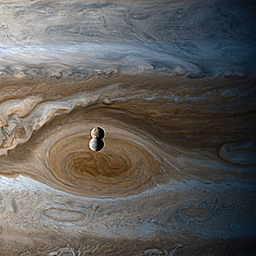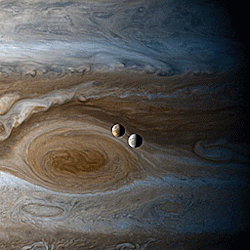Titanoboa
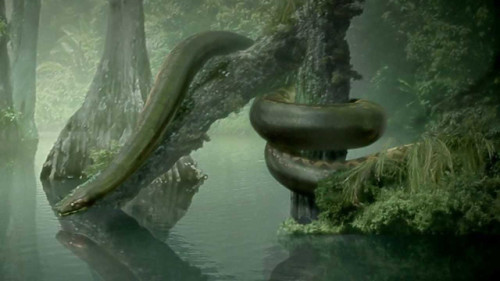

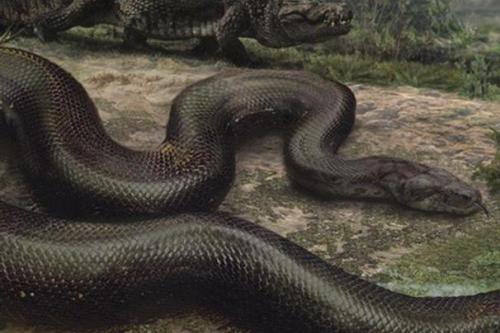
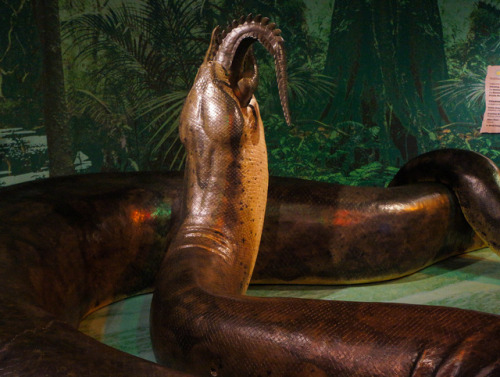
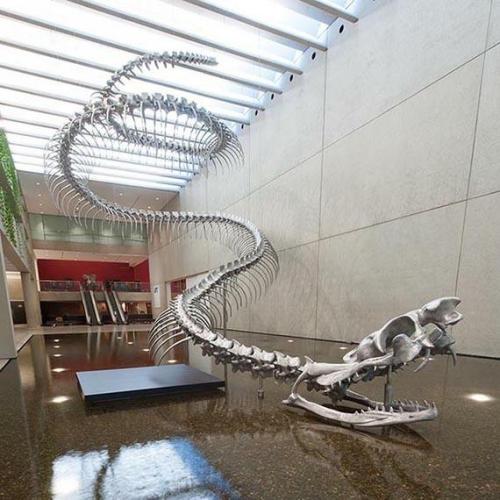

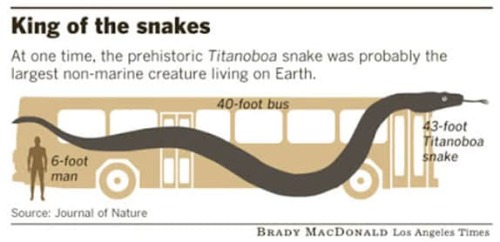
Titanoboa
Titanoboa is an extinct genus of snakes that is known to have lived in present-day La Guajira in northern Colombia. The giant snake lived during the Middle to Late Paleocene epoch, a 10-million-year period immediately following the Cretaceous-Paleogene extinction event.
The only known species is Titanoboa cerrejonensis, the largest snake ever discovered. By comparing the sizes and shapes of its fossilized vertebrae to those of extant snakes, researchers estimated that the largest individuals of T. cerrejonensis found had a total length around 42 feet and weighed about 2,500 pounds.
While initially thought to have been an apex predator of the Paleocene ecosystem in which it lived, evidence has pointed to the genus being predominantly piscivorous. Titanoboa’s massive size would have made it difficult to move on land, so the giant snake would probably have spent most of its life in the water, hunting for fish and other aquatic prey.
More Posts from Starry-shores and Others
So I just discovered that the famous depth chart of Lake Baikal, you know, this one

Is
Uh
Not the whole picture

So this is going to haunt me forever
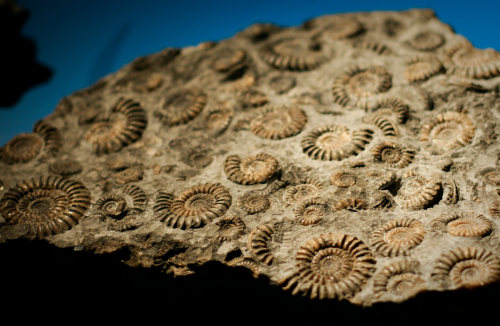
The Ammonoids The Ammonoids are a subclass of cephalopods that inhabited the oceans from the Devonian some 416 million years ago until they went extinct some 65 million years ago. The species evolved and dispersed rapidly around the world and so are some of the best guide fossils for dating the strata in which they are found.
Keep reading
Gamma-ray Bursts: Black Hole Birth Announcements
Gamma-ray bursts are the brightest, most violent explosions in the universe, but they can be surprisingly tricky to detect. Our eyes can’t see them because they are tuned to just a limited portion of the types of light that exist, but thanks to technology, we can even see the highest-energy form of light in the cosmos — gamma rays.
So how did we discover gamma-ray bursts?
Accidentally!

We didn’t actually develop gamma-ray detectors to peer at the universe — we were keeping an eye on our neighbors! During the Cold War, the United States and the former Soviet Union both signed the Nuclear Test Ban Treaty of 1963 that stated neither nation would test nuclear weapons in space. Just one week later, the US launched the first Vela satellite to ensure the treaty wasn’t being violated. What they saw instead were gamma-ray events happening out in the cosmos!

Things Going Bump in the Cosmos
Each of these gamma-ray events, dubbed “gamma-ray bursts” or GRBs, lasted such a short time that information was very difficult to gather. For decades their origins, locations and causes remained a cosmic mystery, but in recent years we’ve been able to figure out a lot about GRBs. They come in two flavors: short-duration (less than two seconds) and long-duration (two seconds or more). Short and long bursts seem to be caused by different cosmic events, but the end result is thought to be the birth of a black hole.

Short GRBs are created by binary neutron star mergers. Neutron stars are the superdense leftover cores of really massive stars that have gone supernova. When two of them crash together (long after they’ve gone supernova) the collision releases a spectacular amount of energy before producing a black hole. Astronomers suspect something similar may occur in a merger between a neutron star and an already-existing black hole.

Long GRBs account for most of the bursts we see and can be created when an extremely massive star goes supernova and launches jets of material at nearly the speed of light (though not every supernova will produce a GRB). They can last just a few seconds or several minutes, though some extremely long GRBs have been known to last for hours!

A Gamma-Ray Burst a Day Sends Waves of Light Our Way!
Our Fermi Gamma-ray Space Telescope detects a GRB nearly every day, but there are actually many more happening — we just can’t see them! In a GRB, the gamma rays are shot out in a narrow beam. We have to be lined up just right in order to detect them, because not all bursts are beamed toward us — when we see one it’s because we’re looking right down the barrel of the gamma-ray gun. Scientists estimate that there are at least 50 times more GRBs happening each day than we detect!

So what’s left after a GRB — just a solitary black hole? Since GRBs usually last only a matter of seconds, it’s very difficult to study them in-depth. Fortunately, each one leaves an afterglow that can last for hours or even years in extreme cases. Afterglows are created when the GRB jets run into material surrounding the star. Because that material slows the jets down, we see lower-energy light, like X-rays and radio waves, that can take a while to fade. Afterglows are so important in helping us understand more about GRBs that our Neil Gehrels Swift Observatory was specifically designed to study them!

Last fall, we had the opportunity to learn even more from a gamma-ray burst than usual! From 130 million light-years away, Fermi witnessed a pair of neutron stars collide, creating a spectacular short GRB. What made this burst extra special was the fact that ground-based gravitational wave detectors LIGO and Virgo caught the same event, linking light and gravitational waves to the same source for the first time ever!

For over 10 years now, Fermi has been exploring the gamma-ray universe. Thanks to Fermi, scientists are learning more about the fundamental physics of the cosmos, from dark matter to the nature of space-time and beyond. Discover more about how we’ll be celebrating Fermi’s achievements all year!
Make sure to follow us on Tumblr for your regular dose of space: http://nasa.tumblr.com
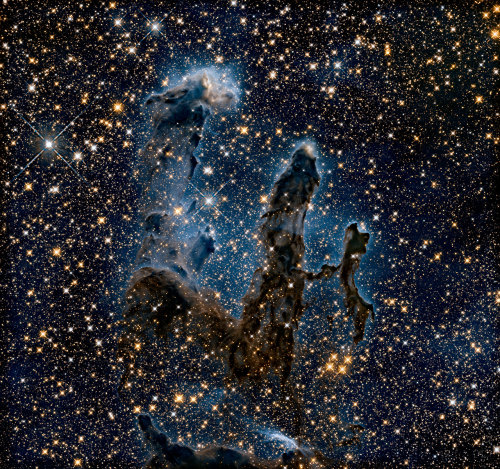
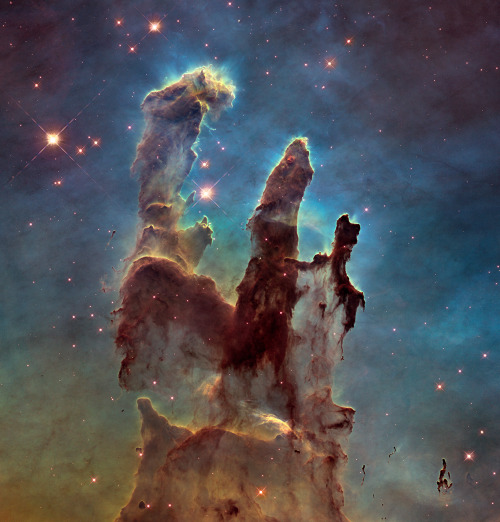
Sometimes… there’s more than meets the eye. 👀 You’re looking at two very different takes on an iconic image.
Human eyes can see only a small portion of the range of radiation given off by the objects around us. We call this wide array of radiation the electromagnetic spectrum, and the part we can see visible light.
In the first image, researchers revisited one of Hubble Space Telescope’s most popular sights: the Eagle Nebula’s Pillars of Creation. Here, the pillars are seen in infrared light, which pierces through obscuring dust and gas and unveil a more unfamiliar — but just as amazing — view of the pillars. The entire frame is peppered with bright stars and baby stars are revealed being formed within the pillars themselves. The image on the bottom is the pillars in visible light.
Image Credit: NASA, ESA/Hubble and the Hubble Heritage Team
Make sure to follow us on Tumblr for your regular dose of space: http://nasa.tumblr.com.
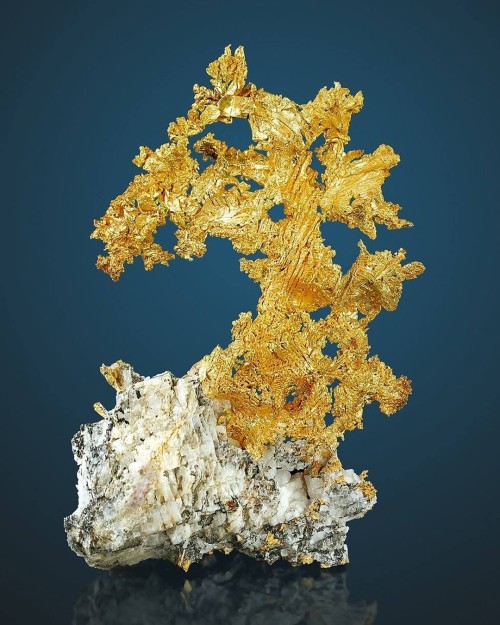
Gold | #Geology #GeologyPage #Minerals #usa
Locality: Eagle’s Nest Mine, Placer Co., California, USA
Size: 9 x 6.1 x 1.8 cm
Photo Copyright © Anton Watzl Minerals
Geology Page www.geologypage.com — view on Instagram https://scontent-iad3-2.cdninstagram.com/v/t51.2885-15/241701518_397503718379467_3401054776149613851_n.jpg?_nc_cat=111&ccb=1-5&_nc_sid=8ae9d6&_nc_ohc=wAvIbpLfPz8AX-dtOaF&_nc_ht=scontent-iad3-2.cdninstagram.com&edm=ANo9K5cEAAAA&oh=65ffb23e4a191f038c3511d14c41803d&oe=61421C8F

50 Foot Long Congo Snake
In 1959 Remy Van Lierden was flying over the Katanga region in the Democratic Republic of the Congo. He was flying a helicopter and returning to the base that he commanded in Kamina. As he passed over a clearing in the jungle he noticed a large animal laying out in the sun. What he saw was a 50 foot long snake, with green and brown scales. He couldn’t believe his eyes and neither could his passengers. He circled around and made several passes off the monstrous snake, however he flew away when it got into the striking position and thought it was too dangerous to contour to fly over the animal. During one of the passes he made a passenger on his aircraft snapped this picture to prove what they saw. The snake in question is clearly large and it’s easy to see how it could have been a threat to a low flying helicopter. It’s believed that the snake is a Titanoboa which is thought to be extinct, and has been for millions of years. But it’s possible that the species may have survived. The natives claim that the snake pictured here is a small one and that they can get up to twice and three times the size.
-
 disofbz reblogged this · 6 months ago
disofbz reblogged this · 6 months ago -
 wildernestt reblogged this · 1 year ago
wildernestt reblogged this · 1 year ago -
 tyvadi liked this · 2 years ago
tyvadi liked this · 2 years ago -
 gloomyglamour liked this · 3 years ago
gloomyglamour liked this · 3 years ago -
 greek-mythographer reblogged this · 3 years ago
greek-mythographer reblogged this · 3 years ago -
 nb-goblin liked this · 3 years ago
nb-goblin liked this · 3 years ago -
 go-shameless-weeb reblogged this · 3 years ago
go-shameless-weeb reblogged this · 3 years ago -
 go-shameless-weeb liked this · 3 years ago
go-shameless-weeb liked this · 3 years ago -
 simeon-with-a-shotgun reblogged this · 3 years ago
simeon-with-a-shotgun reblogged this · 3 years ago -
 lachatalovematcha liked this · 3 years ago
lachatalovematcha liked this · 3 years ago -
 juliana-mont liked this · 3 years ago
juliana-mont liked this · 3 years ago -
 sparklefunshine reblogged this · 3 years ago
sparklefunshine reblogged this · 3 years ago -
 sparklefunshine liked this · 3 years ago
sparklefunshine liked this · 3 years ago -
 liquor-belle reblogged this · 4 years ago
liquor-belle reblogged this · 4 years ago -
 ibelivedinmyself liked this · 4 years ago
ibelivedinmyself liked this · 4 years ago -
 auroras-blend reblogged this · 4 years ago
auroras-blend reblogged this · 4 years ago -
 ohmygoodnesslesbians reblogged this · 4 years ago
ohmygoodnesslesbians reblogged this · 4 years ago -
 ohmygoodnesslesbians liked this · 4 years ago
ohmygoodnesslesbians liked this · 4 years ago -
 starry-shores reblogged this · 4 years ago
starry-shores reblogged this · 4 years ago -
 an-abyss-called-life liked this · 4 years ago
an-abyss-called-life liked this · 4 years ago -
 flffytakei reblogged this · 4 years ago
flffytakei reblogged this · 4 years ago -
 jespers-kind-of-chaos reblogged this · 4 years ago
jespers-kind-of-chaos reblogged this · 4 years ago -
 flffytakei liked this · 4 years ago
flffytakei liked this · 4 years ago -
 enirb0r3h liked this · 4 years ago
enirb0r3h liked this · 4 years ago -
 fawkesofalbion liked this · 4 years ago
fawkesofalbion liked this · 4 years ago -
 lunarthedragon liked this · 4 years ago
lunarthedragon liked this · 4 years ago -
 carbonprodigy liked this · 4 years ago
carbonprodigy liked this · 4 years ago -
 epjol111 reblogged this · 4 years ago
epjol111 reblogged this · 4 years ago -
 vicshush liked this · 4 years ago
vicshush liked this · 4 years ago -
 jespers-kind-of-chaos liked this · 4 years ago
jespers-kind-of-chaos liked this · 4 years ago -
 callmeshei reblogged this · 4 years ago
callmeshei reblogged this · 4 years ago -
 callmeshei liked this · 4 years ago
callmeshei liked this · 4 years ago -
 theofficialkai517 liked this · 4 years ago
theofficialkai517 liked this · 4 years ago -
 pleasantsaladnerd reblogged this · 4 years ago
pleasantsaladnerd reblogged this · 4 years ago -
 pleasantsaladnerd liked this · 4 years ago
pleasantsaladnerd liked this · 4 years ago -
 sarcastic-feminist-witch reblogged this · 4 years ago
sarcastic-feminist-witch reblogged this · 4 years ago -
 sarcastic-feminist-witch liked this · 4 years ago
sarcastic-feminist-witch liked this · 4 years ago -
 greek-mythographer reblogged this · 4 years ago
greek-mythographer reblogged this · 4 years ago -
 greek-mythographer liked this · 4 years ago
greek-mythographer liked this · 4 years ago -
 opheliathestarqueen reblogged this · 4 years ago
opheliathestarqueen reblogged this · 4 years ago -
 opheliathestarqueen liked this · 4 years ago
opheliathestarqueen liked this · 4 years ago -
 ringwraith-4 reblogged this · 4 years ago
ringwraith-4 reblogged this · 4 years ago -
 ringwraith-4 liked this · 4 years ago
ringwraith-4 liked this · 4 years ago -
 luidilovins reblogged this · 4 years ago
luidilovins reblogged this · 4 years ago -
 thejackeh reblogged this · 4 years ago
thejackeh reblogged this · 4 years ago -
 thejackeh liked this · 4 years ago
thejackeh liked this · 4 years ago -
 prince-winter-of-icewings liked this · 4 years ago
prince-winter-of-icewings liked this · 4 years ago -
 loneicedragon liked this · 4 years ago
loneicedragon liked this · 4 years ago

Amateur astronomer, owns a telescope. This is a side blog to satiate my science-y cravings! I haven't yet mustered the courage to put up my personal astro-stuff here. Main blog : @an-abyss-called-life
212 posts

